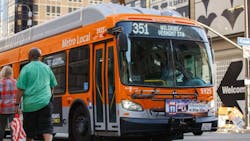L.A. Metro Board approves NextGen Plan to improve bus system
The Los Angeles County Metropolitan Transportation Authority (L.A. Metro) Board of Directors approved the Next Gen plan to restructure the authority’s bus system.
The plan will increase frequency of buses, improve service on most routes and put more buses in areas with the greatest demand.
NextGen has been in the works for nearly three years and is the most sweeping overhaul of the bus system in 25 years. Under the new plan — to be implemented in stages, beginning in December — buses will arrive every five to 10 minutes for 83 percent of current riders compared to around 48 percent today.
L.A. Metro runs the nation’s second busiest bus system, but ridership has declined over the last decade. The NextGen plan is a direct response to better serve existing riders and attract new ones. NextGen is also a blunt acknowledgement that the agency’s bus fleet does the heavy lifting ridership-wise, carrying more than 70 percent of L.A. Metro’s boardings on a typical day. L.A. Metro’s own data indicates that its bus system is a mobility lifeline for numerous riders who don’t have many choices on how to get around. Bus riders have an average annual income of almost $27,000 (prior to the pandemic) and 57 percent are impoverished.
What riders need to know:
- L.A. Metro will make changes to service over its next three planned service changes — in December 2020, June 2021 and December 2021. Most changes will come in June 2021.
- Prior to any service changes, L.A. Metro will provide notice to riders both via signage and online to ensure the public is informed of the service changes.
- When the plan is fully implemented, the number of bus lines running every five to 10 minutes on weekdays would jump from 16 to 29 and from two to 14 on weekends.
- As a result, the number of Los Angeles County residents who could walk to bus lines running every five to 10 minutes would more than double from 900,000 currently to almost 2.2 million.
- Under the plan, most local and rapid buses will be combined. These new lines will stop fewer times than a local bus but a few more than a rapid. Transit signal priority that has been a key part of rapid service will also now work these new lines. The result will be a faster door-to-door trip for all riders, whether they currently take L.A. Metro Local or Rapid routes. On average stops would be a quarter mile apart.
- The 720 (Wilshire Boulevard), 754 (Vermont Avenue) and 761 (Van Nuys Blvd. to the Westside) will continue in service.
- In a small number of cases, an L.A. Metro bus line will be operated by one of L.A. County’s many municipal bus systems — particularly in areas where L.A. Metro bus service currently overlaps with other transit providers.
- In some areas with bus service that is perpetually underused or areas that are difficult to serve with full-sized buses on fixed routes, L.A. Metro is planning on launching an on-demand shuttle bus service called Metro Micro. The initial two Metro Micro service areas are scheduled to launch in December. Four additional zones are planned to launch in mid-2021.
- NextGen was approved by L.A. Metro’s Service Councils over the summer and public hearings were held. Based on public input 35 changes were made to the draft plan — mostly restoring service in some areas. Overall, more than 300 meetings were held as the NextGen Plan was developed and more than 18,000 comments from the public received.
One new challenge going forward for NextGen will be restoring service. In response to safer-at-home orders and a drop in sales tax revenues and ridership, L.A. Metro is running on average about 80 percent of its normal service this fiscal year for roughly half the pre-COVID number of riders.
To fully implement NextGen as envisioned, L.A. Metro will need to increase service back to pre-pandemic levels. That has been a particular focus of some L.A. Metro Board Members and stakeholders in recent weeks. L.A. Metro staff are due to deliver a plan to the board later this year on how the agency plans to increase service while dealing with funding issues related to the pandemic.
The plan for now — pandemic and funding permitting — is to add service as demand grows so that the authority can return to pre-COVID-19 service levels. L.A. Metro Board Chair and L.A. Mayor Eric Garcetti said funding will be available to add enough service to meet NextGen’s goals.
Additionally, several bus rapid transit projects with funding from the Measure M sales tax are in the planning stages and L.A. Metro staff continue to work with cities across L.A. County on improvements including bus lanes, traffic signal priority and more comfortable bus stops with better protection from the elements and more rider data.



